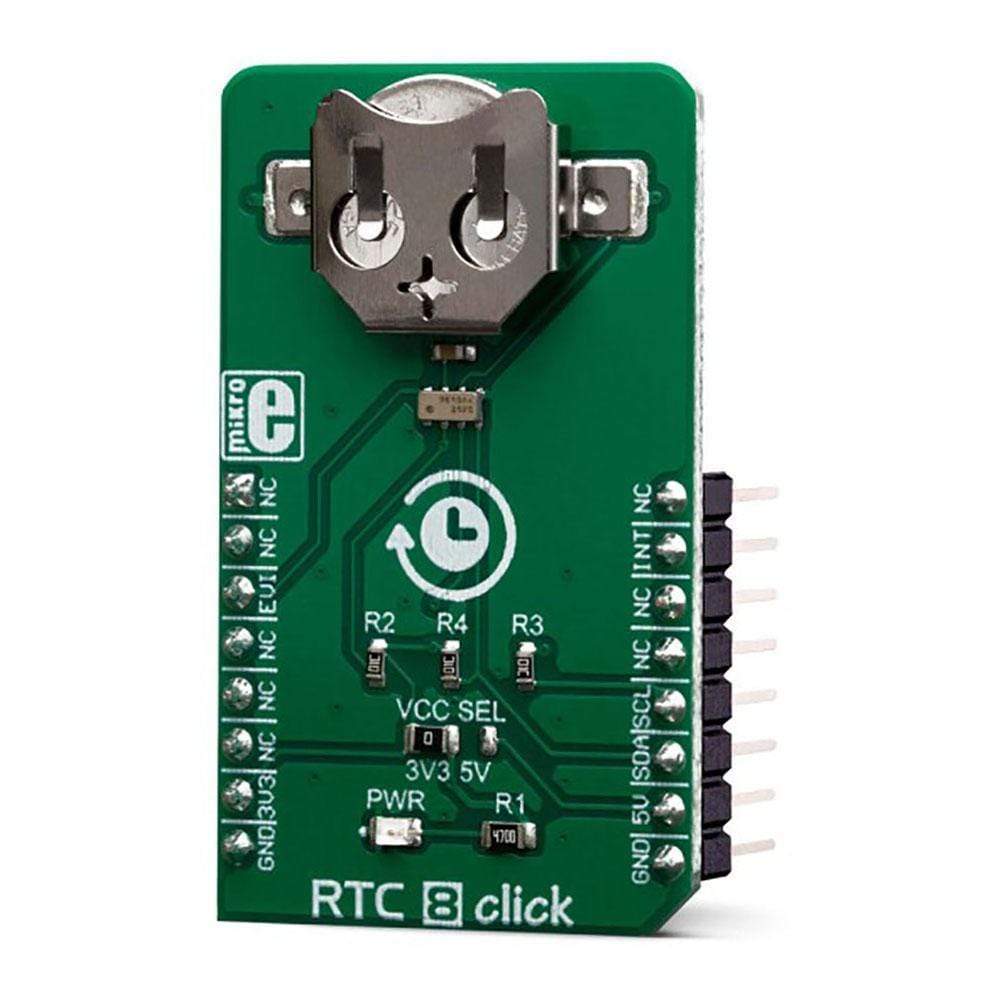
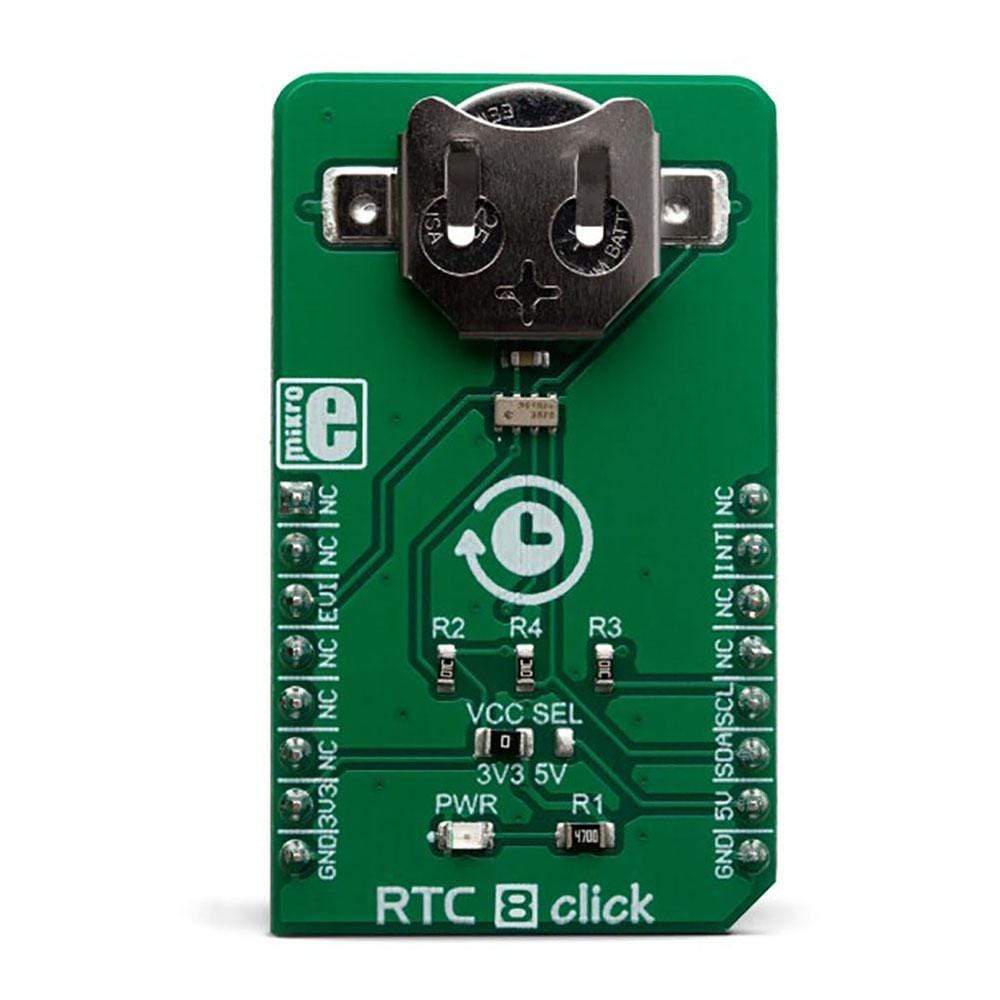
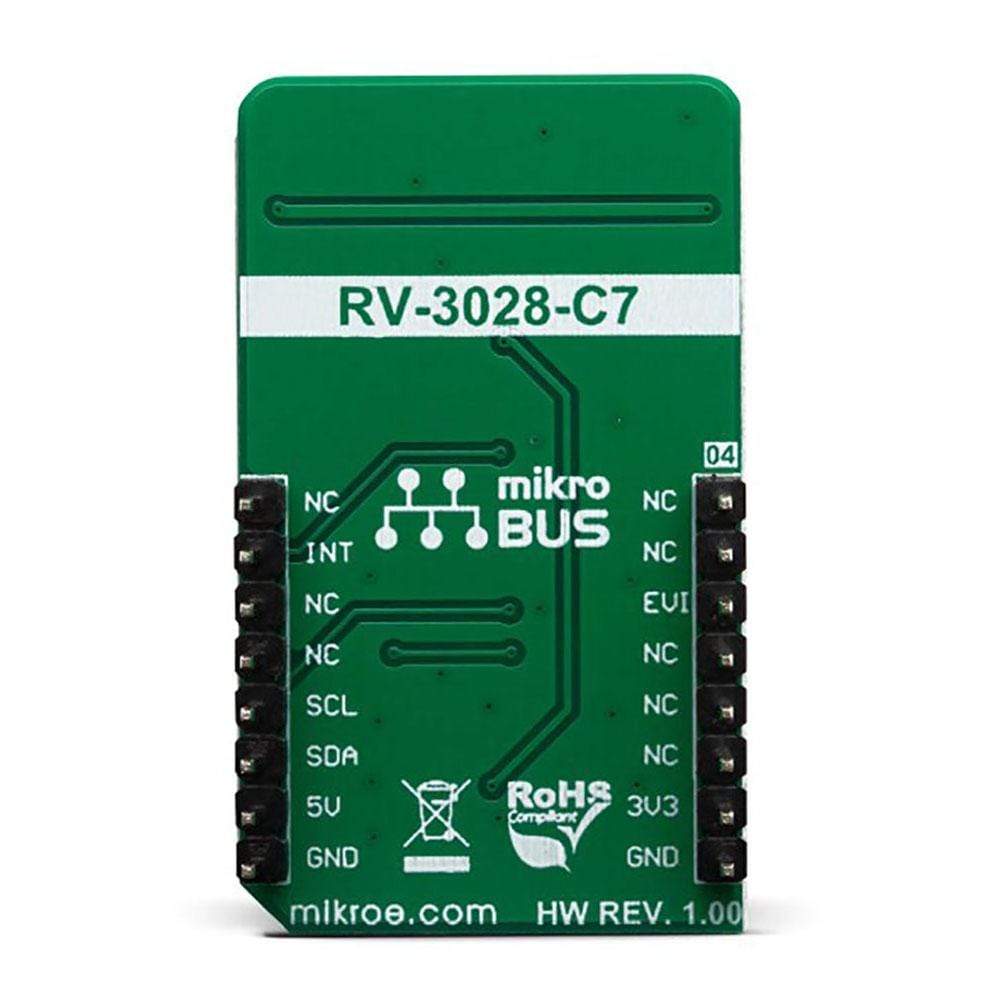
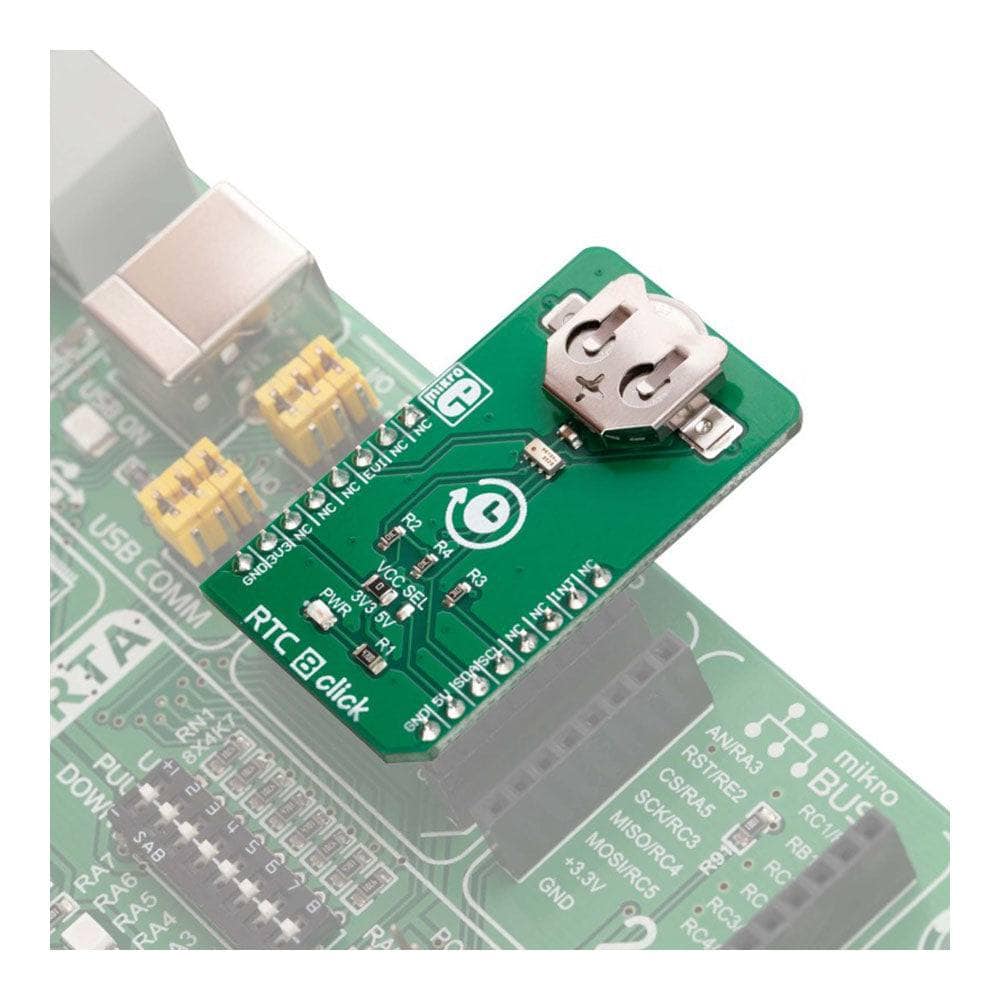
Key Features
Overview
The RTC 8 Click Board™ is a real-time clock module that has an extremely low power consumption, allowing it to be used with a single button cell battery, for an extended period of time. The RV-3028-C7 module built on the RTC 8 Click Board™ is able to output the time in the standard format, as well as in the 32-bit UNIX format. Integrated, factory calibrated crystal operating at 32.768 kHz ensures a very low time deviation.
The compensation and offset data are stored within the internal non-volatile memory. There is also a possibility to password-protect the configuration parameters. An advanced interrupt feature allows many different uses such as alarm function, countdown timer function, external event detection function with time stamp and much more.
Downloads
Features such as the ability to be powered over the button cell battery, external event capture pin, several time output formats including the 32-bit UNIX counter format, and above all – an extremely low-power consumption, make the RTC 8 Click Board™ a perfect solution for the development of the IoT, wearable and portable applications, logging devices, industrial and health-related time metering applications, and all the other applications that require an accurate RTC for their operation
How Does The RTC 8 Click Board™ Work?
The RTC 8 Click Board™ is based on the RV-3028-C7, an extreme low-power real-time clock/calendar (RTC) module from Micro Crystal Switzerland. Thanks to its high integration level, this module provides high time accuracy, factory calibrated to 1 ppm, with a very low count of external components required. It has a full RTC function, offering programmable counters, alarms, and an interrupt engine with selectable event reporting sources. In addition to a standard clock output function, it also offers a 32-bit UNIX Time counter. The operational parameters are stored within the internal non-volatile memory (EEPROM) allowing their persistence in the event of the complete power failure. The small dimension of the RV-3028-C7 module itself, allow it to be used in very space-constrained applications, including wearables, medical equipment, and similar.
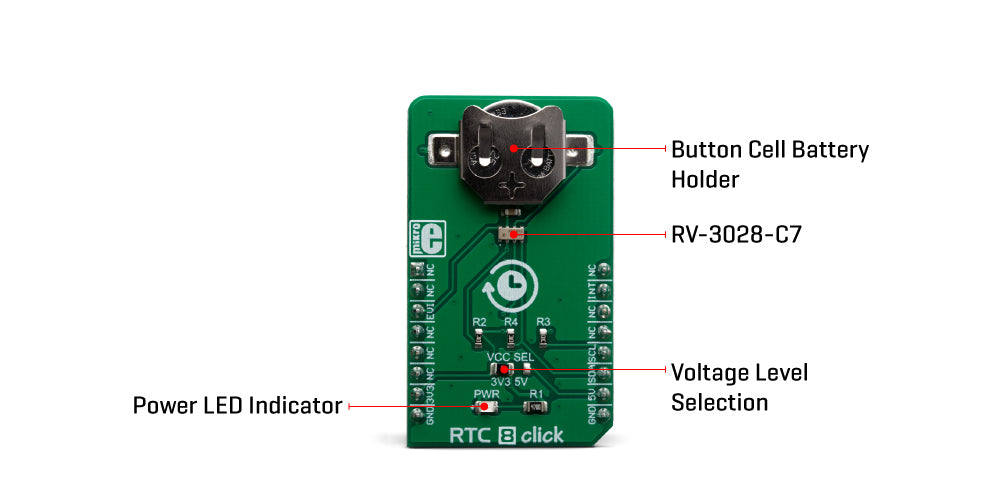
In addition to the RV-3028-C7, RTC 8 Click Board™ is equipped with the button cell battery holder compatible with the CR1225 battery. By utilising an automatic backup switch, the IC is able to use an external battery power source when there is no power supply on its main power terminals, thus allowing for uninterrupted operation. Draining as low as 40nA of current, it can be operated with the standard button cell battery almost indefinitely. In addition, a trickle charge system will replenish the battery power while the RV-3028-C7 is powered over the main power terminals (VDD, VSS). The voltage of the main power supply can range between 1.2V up to 5.5V.
The RV-3028-C7 uses the I2C communication protocol for the communication with the host MCU. Besides the I2C bus lines, two additional pins are also available on the RV-3028-C7, allowing an interrupt to be reported to the host MCU, but also to capture an external event and marking it with an automatic timestamp. The user is able to set up standard clock and calendar functions (including seconds, minutes, hours, weekdays, date, months, years with leap year correction), as well as the interrupt functions for the periodic countdown timer, periodic time update, alarm, external event, automatic backup switchover and power on reset (POR) events. All these features are available when the module is operated over the backup power supply (battery)
A group of configuration registers is used to set up all the various working parameters of the device. To additionally prevent any unintentional changes of the internal registers, the RV-3028-C7 offers password protection of its configuration. If the password protection is set by an enable register in the non-volatile memory, each time the register configuration is attempted, the user will be required to enter the password first. Naturally, reading out the password registers will return 0 values; this register is write-only.
Besides other functions, EEPROM memory holds the offset correction values. Offset correction is required for fine-tuning the internal 32.768 kHz XTAL, as well as for compensating the aging phenomenon.
As mentioned before, the RV-3028-C7 is able to be operated across a wide voltage range, from 1.2V to 5.5V. This allows adding a small SMD jumper on the board, used to select between 3.3V and 5V for its main power supply.
SPECIFICATIONS
| Type | RTC |
| Applications | The RTC 8 Click Board™ is a perfect solution for the development of the IoT, wearable and portable devices, logging devices, industrial and health-related time metering applications, and all the other applications that require an accurate time-base for various purposes. |
| On-board modules | RV-3028-C7, an extreme low-power real-time clock/calendar (RTC) module from Micro Crystal Switzerland |
| Key Features | Extensive interrupt event reporting engine, ability to use a backup battery, trickle charging of the battery for extended operation, provides both standard time/date, as well as the UNIX 32-bit time counter, and more |
| Interface | I2C |
| Compatibility | mikroBUS |
| Click Board™ size | M (42.9 x 25.4 mm) |
| Input Voltage | 3.3V or 5V |
PINOUT DIAGRAM
This table shows how the pinout on RTC 8 Click Board™ corresponds to the pinout on the mikroBUS socket (the latter shown in the two middle columns).
| Notes | Pin |  |
Pin | Notes | |||
|---|---|---|---|---|---|---|---|
| NC | 1 | AN | PWM | 16 | NC | ||
| NC | 2 | RST | INT | 15 | INT | Interrupt OUT | |
| External Event IN | EVI | 3 | EVI | TX | 14 | NC | |
| NC | 4 | SCK | RX | 13 | NC | ||
| NC | 5 | MISO | SCL | 12 | SCL | I2C Clock | |
| NC | 6 | MOSI | SDA | 11 | SDA | I2C Data | |
| Power Supply | 3.3V | 7 | 3.3V | 5V | 10 | 5V | Power supply |
| Ground | GND | 8 | GND | GND | 9 | GND | Ground |
ONBOARD SETTINGS AND INDICATORS
| Designator | Name | Default | Description |
|---|---|---|---|
| PWR | PWR | - | Power LED Indicator |
| VCC SEL | VCC SEL | Left | Power supply voltage selection: left position 3.3V, right position 5V |
| General Information | |
|---|---|
Part Number (SKU) |
MIKROE-3456
|
Manufacturer |
|
| Physical and Mechanical | |
Weight |
0.02 kg
|
| Other | |
Country of Origin |
|
HS Code Customs Tariff code
|
|
EAN |
8606018714995
|
Warranty |
|
Frequently Asked Questions
Have a Question?
Be the first to ask a question about this.




